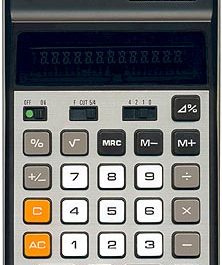
The Casio Memory A-1 calculator, also known as the H-814, was a compact handheld calculator manufactured by Casio Computer Co. Ltd. in Japan around 1977. This solid and small square calculator featured a two-piece plastic case with a white base and a dark brown top. It had a large brushed aluminum keyboard surround and squishy but positive Casio keys, along with an on/off switch on the left side, in line with the display.

The calculator measured approximately 74mm x 117mm x 18.5mm (width, height, depth) and weighed around 88 grams, excluding batteries. It was powered by a single AA-size battery, although it also accepted an optional AD-1S adaptor (0.12W) through a top side socket on the left.

The display was an 8-digit blue VFD (Vacuum Fluorescent Display) without a ninth digit. In terms of features, the Memory A-1 offered basic four-function arithmetic operations (addition, subtraction, multiplication, and division), along with percentages, square root, change sign, and a three-function memory.

The calculator came with a black plastic leatherette cover featuring embossed “Casio” on the front and “Made in Japan” on the back. The original box was calculator-sized, measuring approximately 80mm x 140mm x 26mm, and was printed in black and lime green. The four-language (multiple languages) manual, in black and white, was a 20-page booklet that provided examples of various calculations.

Logic:
- The Clear key (C) cleared the last entry, while the All Clear (AC) key reset the calculator.
- Overflow on the input of a number was suppressed.
- The constant function was activated by pressing the operator twice for all operators.
- The negative sign was shown on the immediate left digit, limiting negative numbers to seven digits. However, if an eight-digit number was entered and the change sign button was pressed, it was ignored.
- Negative square roots were allowed.
- Divide by zero and overflow errors were indicated by an “E.” in the far left (first) digit, and these errors were not recoverable.
- Memory storage was not visually indicated; users had to remember if a value was stored in memory.
- The calculator suffered from the “negative zero” bug, where entering the sequence (1)(-)(2)(=) to give “-1” and then pressing (+)(1) would result in “-0”.

In summary, the Casio Memory A-1 was a basic, compact calculator with a simple design and limited functionality compared to modern calculators. While it offered essential arithmetic operations and a memory function, its logic had several limitations, including error handling issues, constraints on negative numbers, and bugs like the “negative zero” problem.


